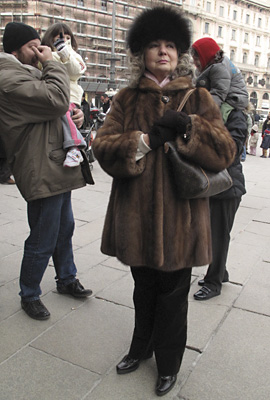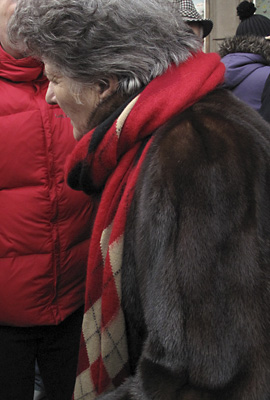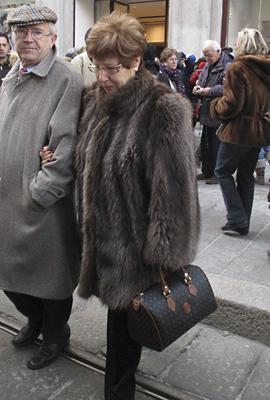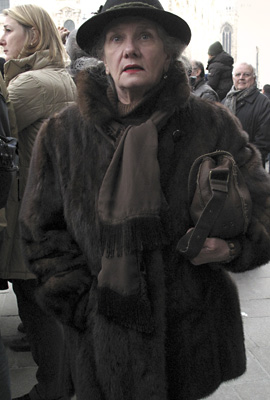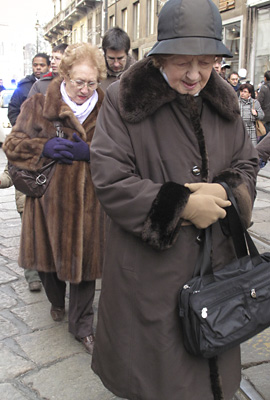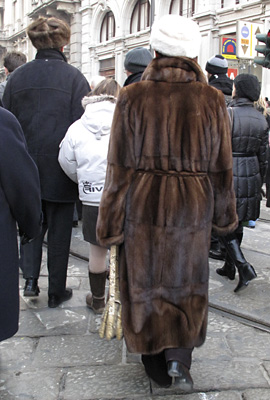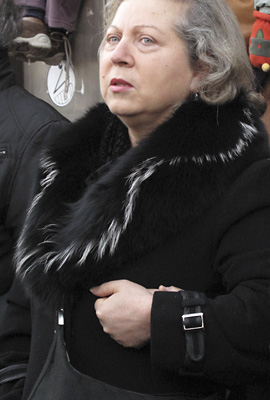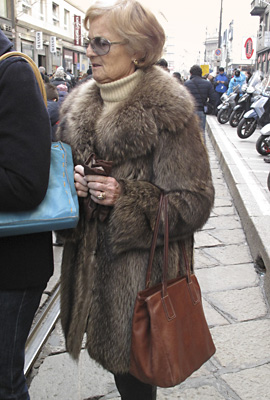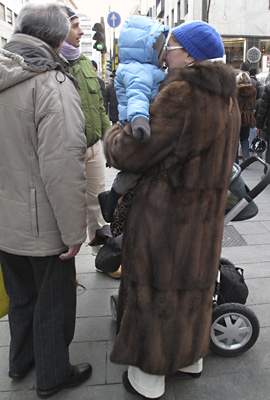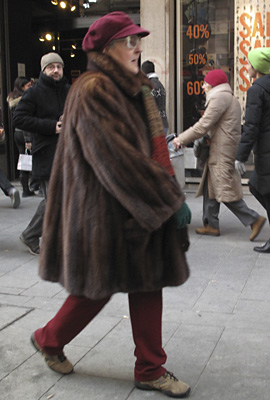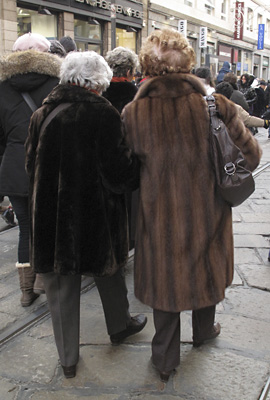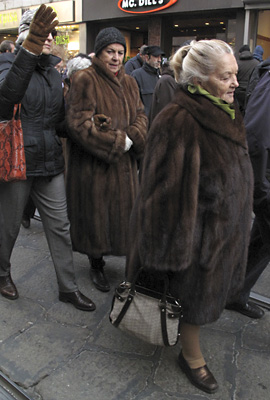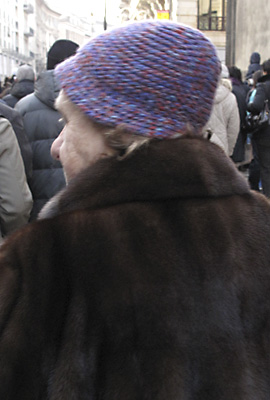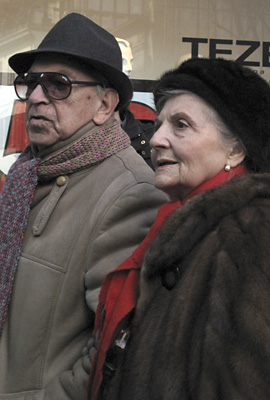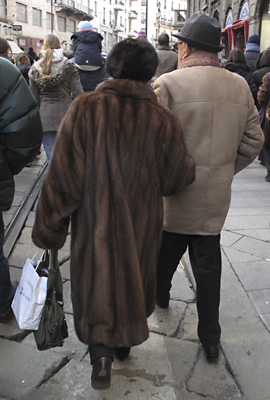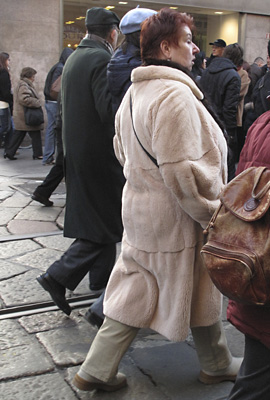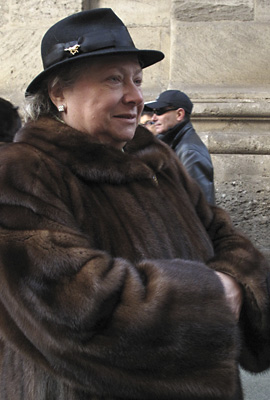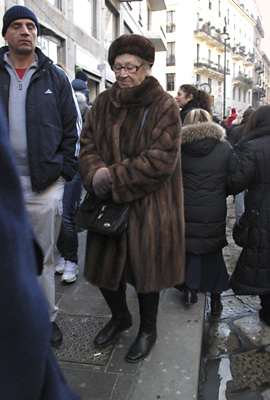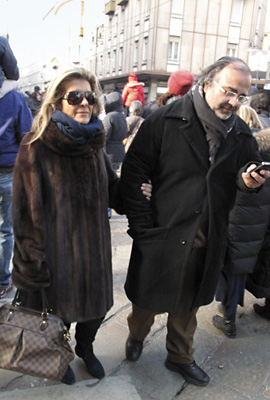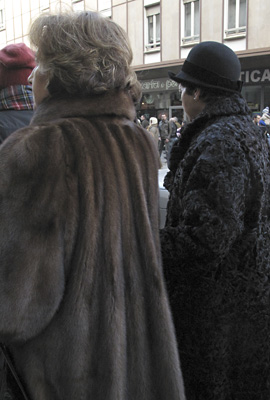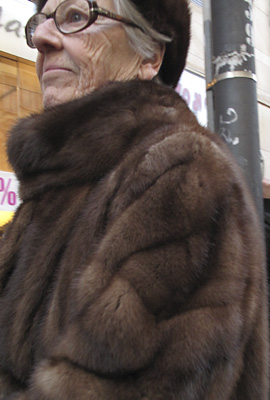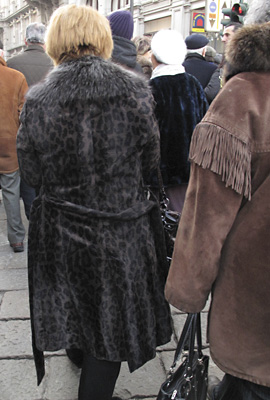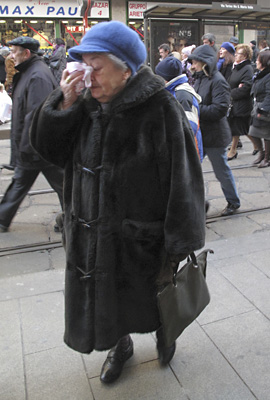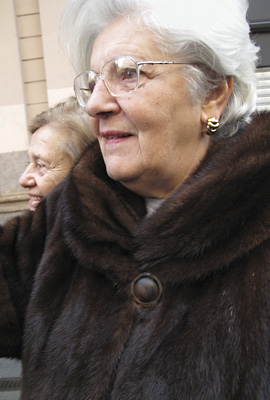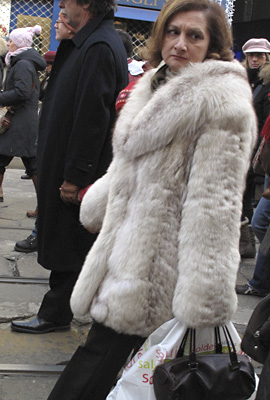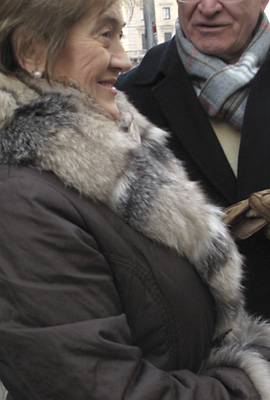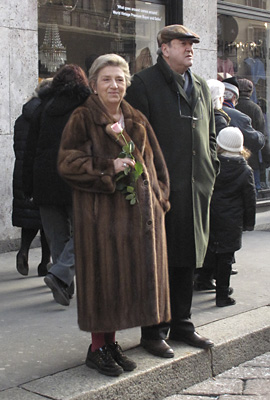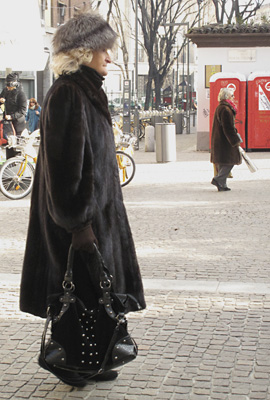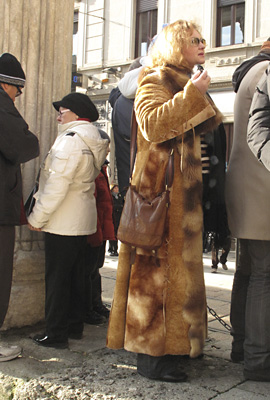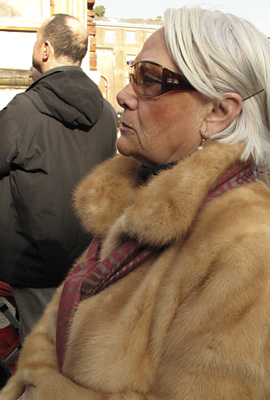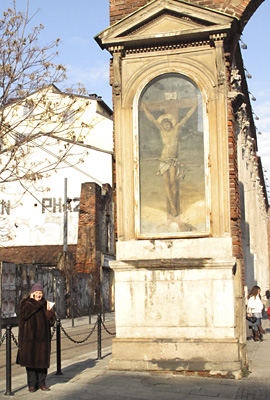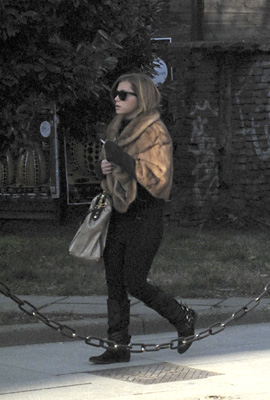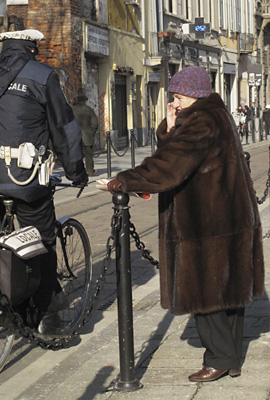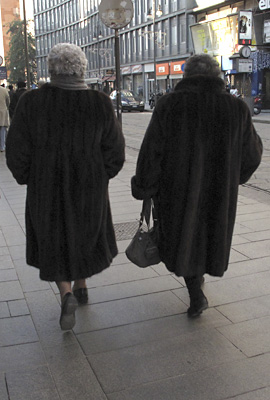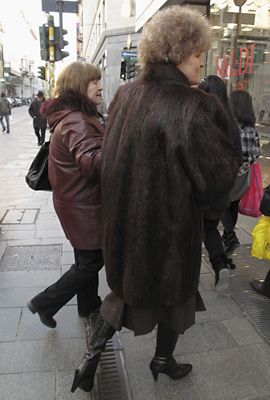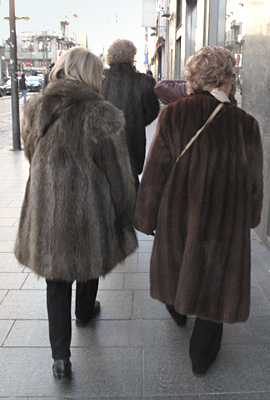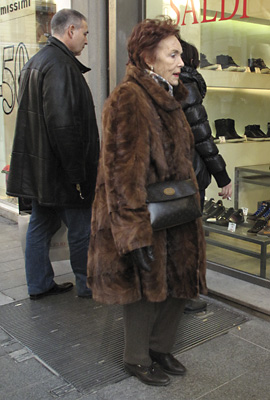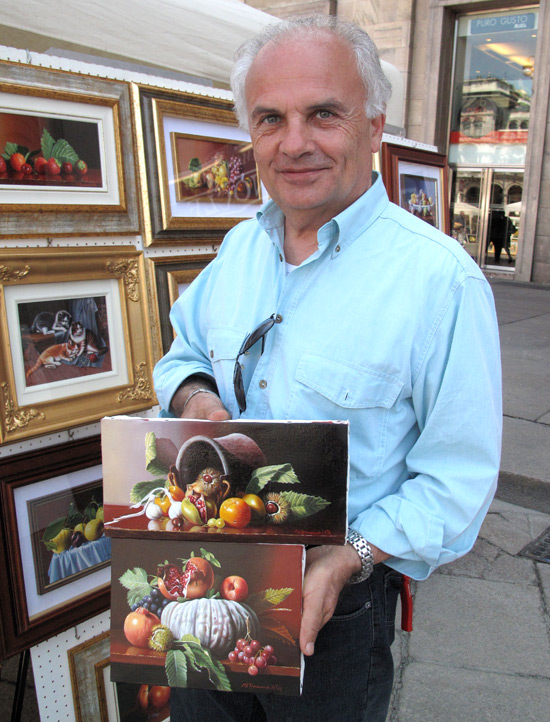
by Maureen | May 23, 2010 | Discoveries, Featured Articles, Graffiti & Street Art, Journal, People, Photo of the Day, Photos
It was another sunny afternoon and a good time to go to the Piazza del Duomo to wander around. I hadn’t known that there was a sidewalk art sale going on. Much of the work was very mediocre, as if the artists were uncertain. I saw the work of a few painters that showed surety, fresh thinking, sophistication and a developed style. And then I saw Nino’s work, and it stopped me.
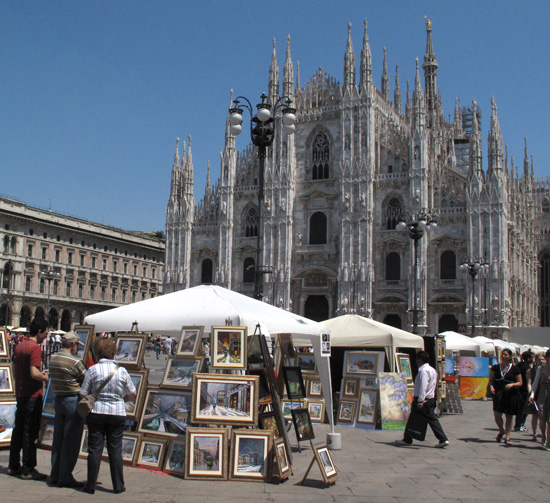
.

In the last year I have seen so much art of the old masters in the great museums and galleries of Italy and France. Portraits, landscapes, abstracts… and still lifes. When I saw the small oil paintings of Nino L’Annunziata, I could have been in the Uffizi or the Louvre. He has a finezza, a fineness, an eye and hand, a sense of color and detail that I don’t often come across in contemporary painters, especially in a casual sidewalk display. Nino has skill, control and certainty that elevate him to “contemporary master”.
We talked for about 45 minutes in an engaged, pleasant chat. We gave each other the classic two-cheek kiss, said goodbye and I walked away with two of his small paintings. When I take them back to Seattle, they will bring to mind a pleasant connection with a fine artist on a sunny, early summer day in Italy. And I will smile.
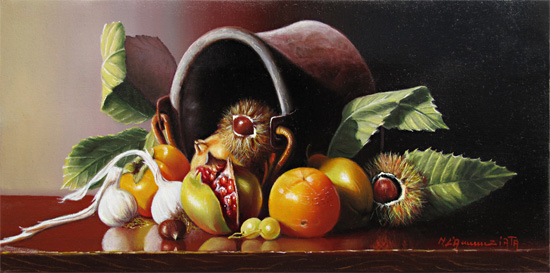
.
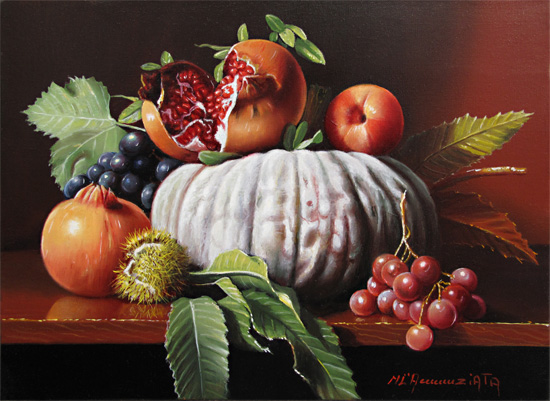
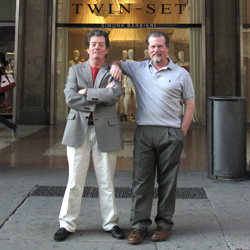
by Maureen | Apr 29, 2010 | Featured Articles, Food!, Journal, Meals, People, Photo of the Day, Photos, Quips
Boy! My two cousins come into town and a riot ensues!
Connie and Gerry arrived yesterday morning, crashed out for a nap then wandered the town for a while. I met them in the evening at their Duomo-close hotel and we goofed around the piazza for a while.
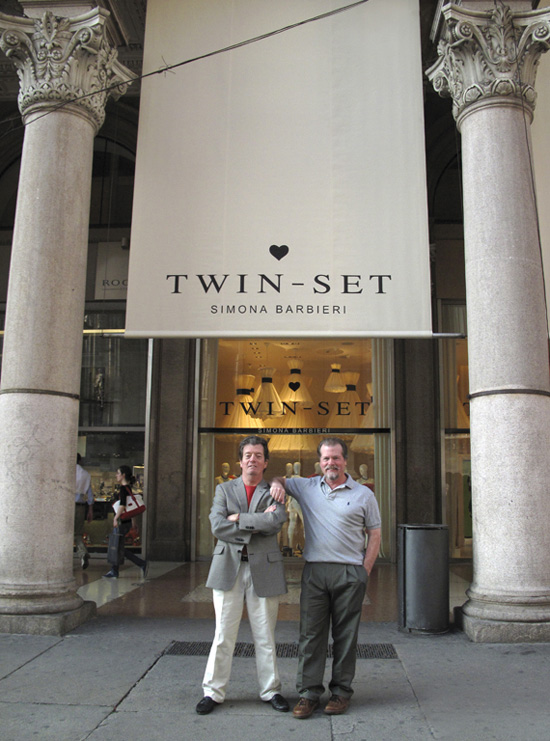
Connie succumbed to the bird food man, mistakenly opening his hand when the guy thrust corn at him. These guys offer you corn, the birds land all over you, your friends take pictures of you with the Duomo in the background and you give corn-man some money.
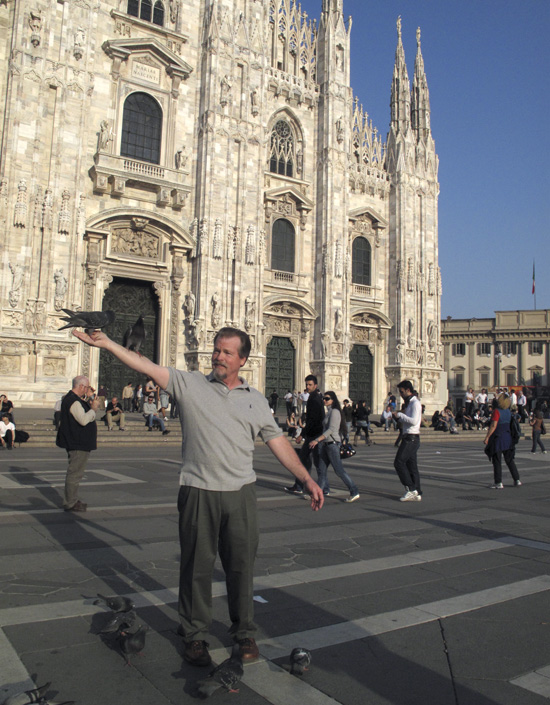
Our 8:00 dinner reservation was early by Italian standards, and we wanted to find a place for a little pre-dinner drink. We decided to head to the Porta Romana neighborhood and look for a place near the restaurant. Down, down, down, deep into the subway system to the yellow line. We rode 4 stops and ascended to an arch, an old wall, and one of the busy circle roads ringing the city. We walked. And walked. Nothing like a long stroll after a long plane flight. Though we passed several cafés along Monte Nero, it was a frenzied, noisy street and we had hoped for something more quiet. We didn’t find it.
We went on to Osteria La Cala (Viale Monte Nero 63) a bit early, and were the first patrons. The menu review, selection and ordering that followed was every bit the best of comedies and tragedies. Certainly, we tested the patience of the woman serving us! She and I discussed the menu items, specialties of Sardegna, and Connie was sure we had just relayed our life stories twice over.
Finally (!) a wine selection was made, and the waitress made the decision to bring us a selection of hot appetizers, plus raw scampi and prawns for each of us.
The octopus was incredibly tender. The stuffed fish roll was topped with fava beans and delicious. The scampi crudi and gamberi rossi crudi were fresh and light.
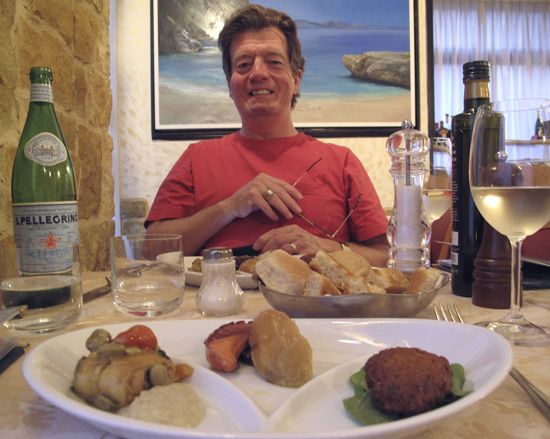
Just TRY to get these two guys to decide what to eat! After much discussion and many more “relays of life stories” (according to Connie), we decided on the pescatrice, (that funny fish with the “lure” hanging off its nose), gnocchi with truffles and shrimp, and lorighitas with calamaretti and bottarga.
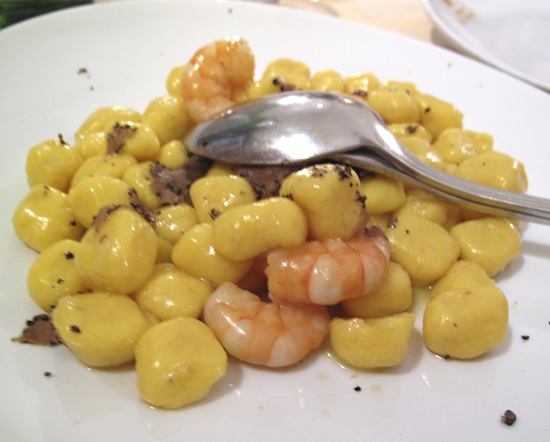
Bottarga is a dried fish roe sac, often served by being thinly sliced and/or grated over pasta. There are many bottarga variations depending on the fish roe used, place of origin and style of preservation.
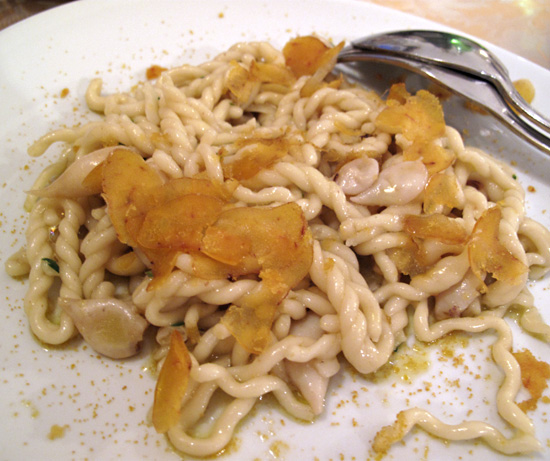
We closed the place down. The few other restaurant patrons had left long ago, and we were, of course, undecided about whether to have any dessert or caffé. Our wonderful waitress saved us from ourselves by bringing us a plate of little sweets, a bottle of Mirto digestif right out of the freezer, and 3 little shot glasses. I’d swear that bottle was full when she brought it to us, but there’s surely no way we could have drunk over half the bottle! Apparently, it’s bitter flavor grew on us.
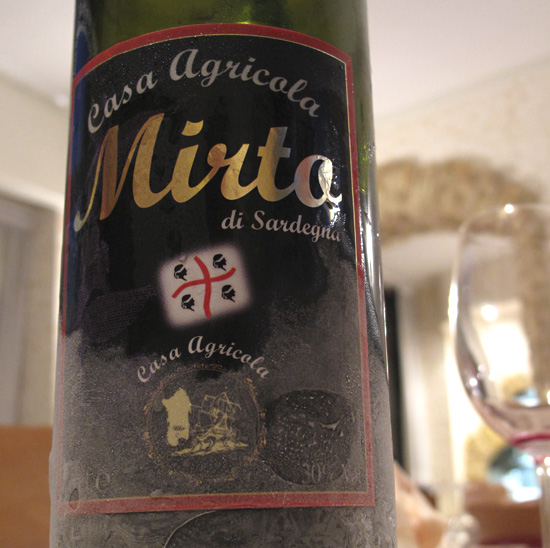
We exchanged handshakes, grazie and much laughter with the restaurant owner, our dear waitress and the kitchen staff. Just outside the front door, we waited for the cable car tram with the intention of riding it to a location near my apartment so the guys could see where I live.
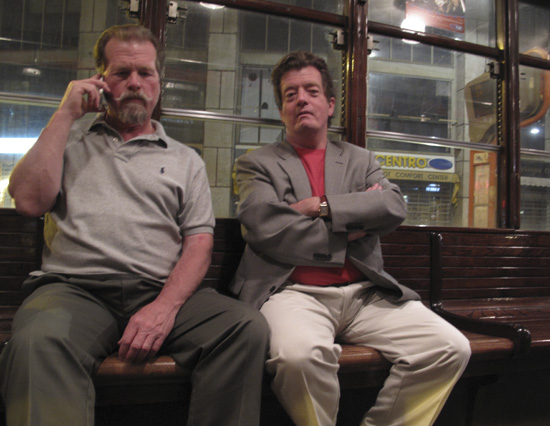
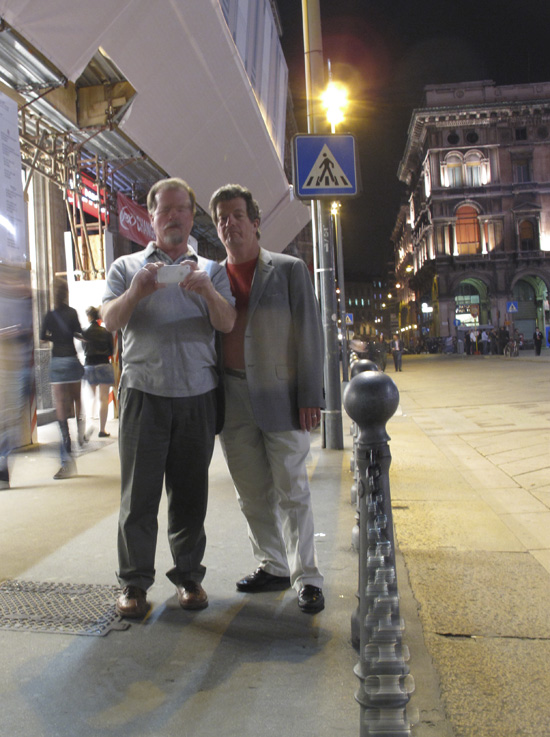
.
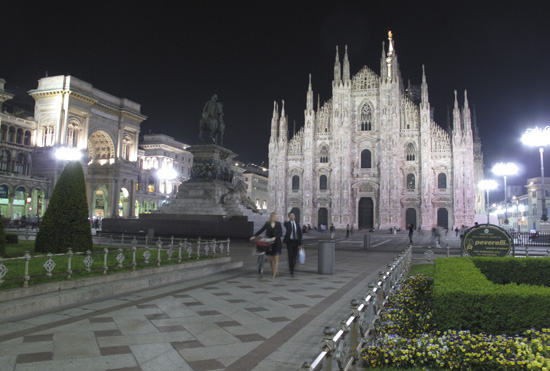
It was the wrong tram. We ended up back at the Duomo, just as honking cars, canned fog horns and delirious fans started streaming in from all directions and clustered in the Piazza del Duomo, Milan’s living room. We were caught in the middle of it all. Milan’s Inter soccer team had just won against Barcelona and there was some serious celebration to be done. The local polizia hung back at the edge of the crowd to keep an eye on things. At the height of it all, Gerry and I lost Connie, consumed in the crowd.
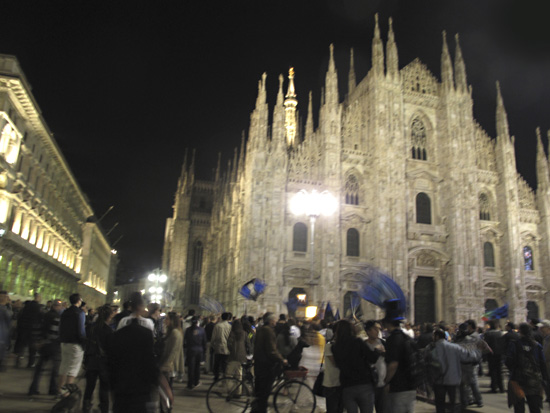
.
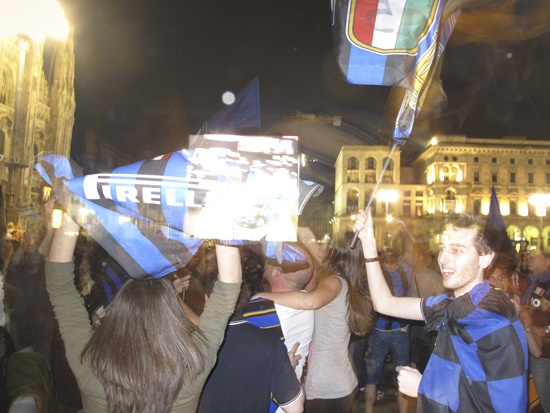
.
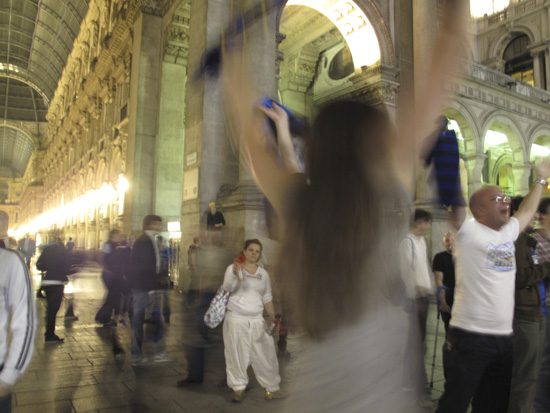
We called him, found him and all headed back to their hotel room to get their better cameras. They wanted to come back out and shoot more serious shots, but got bogged down by their technology tethers.
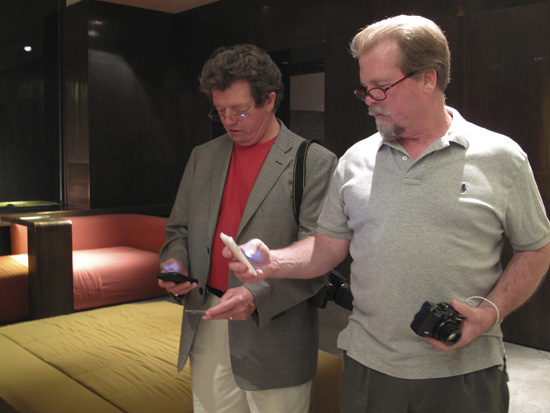
.
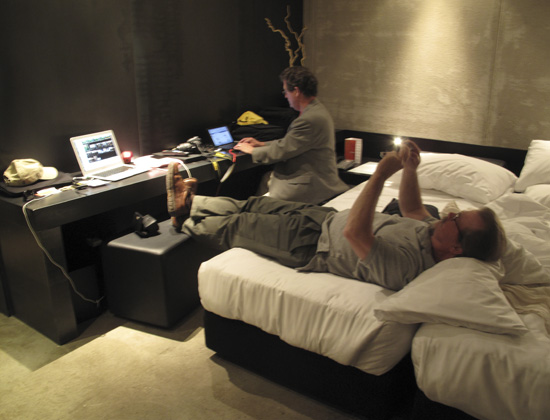
Connie did his ode to Sir Isaac Newton.
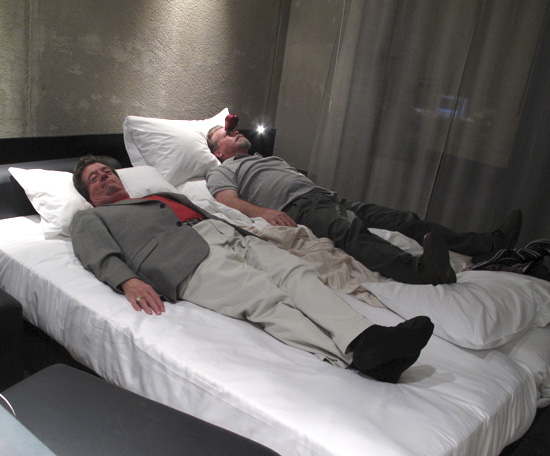
It was fast approaching 1:00 in the morning and I hustled these guys out of their room to walk me to the subway stop at the Duomo. Good thing I did! I caught the LAST westbound red line run before they closed it for the night. I transferred to the green line, got off at Romolo and exited as a guy was standing there ready to lock the gate for the night!
I tell ya, those twins are trouble!
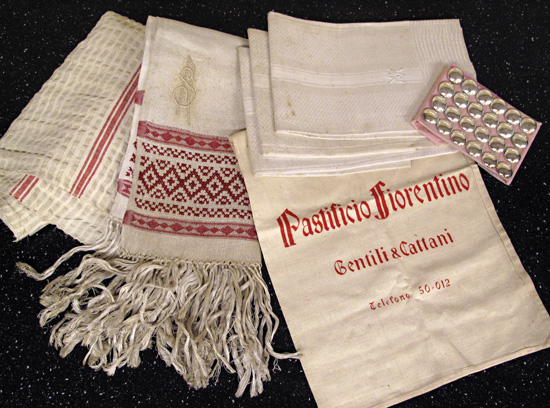
by Maureen | Mar 30, 2010 | Discoveries, Featured Articles, Firenze, Incredible Locations, Journal, Photos, Shopping & Markets
It was as a Camp Fire Girl in fifth grade that I learned to sew by stitching along the lines of binder paper. I’ve been sewing by machine and by hand ever since and fabric is one of the things that makes my heart rate pick up. (Literally.) So, put me in a place where I can find antique fabric, handwork and sewing “notions” and I think I’ve gone to heaven. I passed up some red-on-white cross-stitch samplers from the late 1800s either because they weren’t well-wrought, or the price was higher than I was willing to spring for. I did bring home this little bundle which I will wash up and actually use: embroidered hand towels and napkins, sterling buttons and a muslin flour sack. (I’m easily amused.)

Can you believe I found MY initials embroidered?!
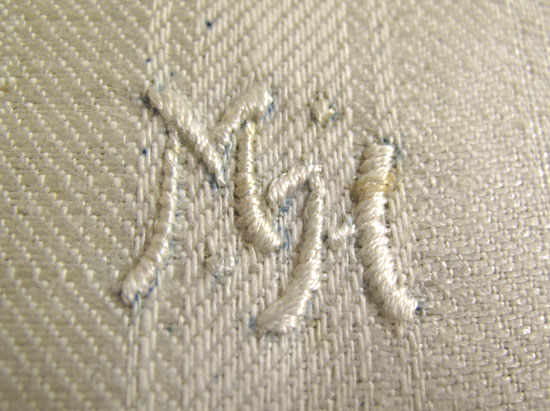
There was a box of about 10 dozen sterling silver buttons produced for Italian military uniforms. Each is marked with “Milano” on the back, which I think is more beautiful than the high-polish front. (I’ll take steel wool to the surface to rough them up, then use them on a special jacket I’ll make.)
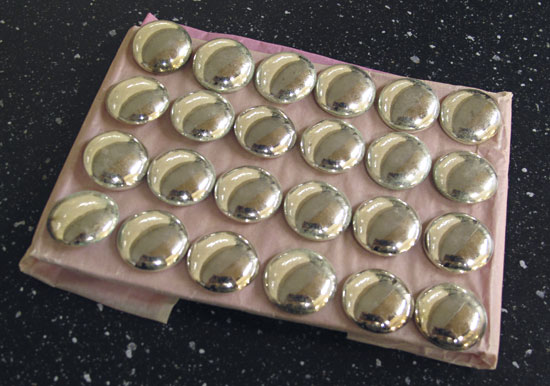
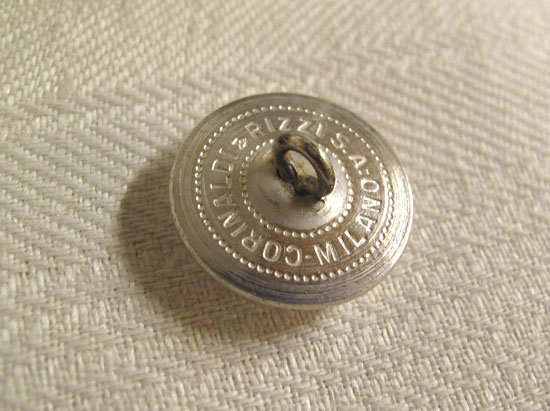
This is elaborate raised stitching on the damask, woven patten.
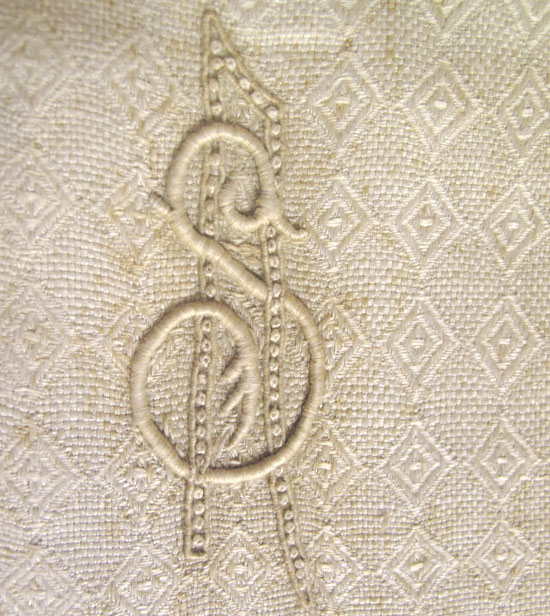
This fringed towel features hand-wrought, counted cross-stitch in between two woven borders.
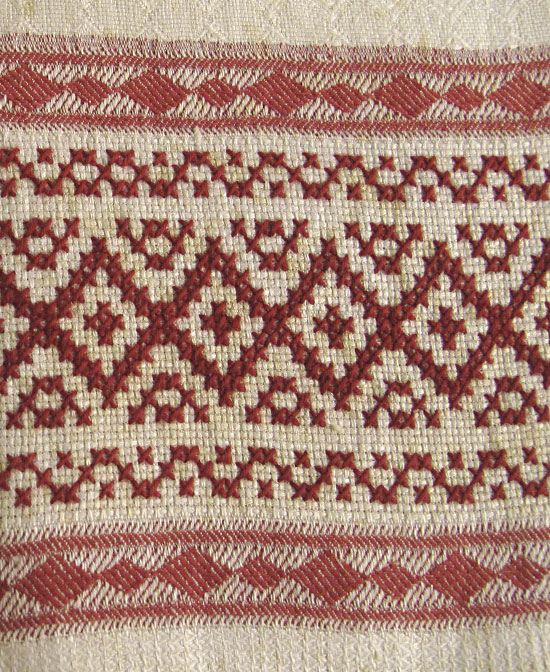
This was a sign on the door of a little shop where they do “polishing, lacquering, restoration and gilding” and sell antique furniture and frames. “Excuse me, would you be willing to sell your sign?”
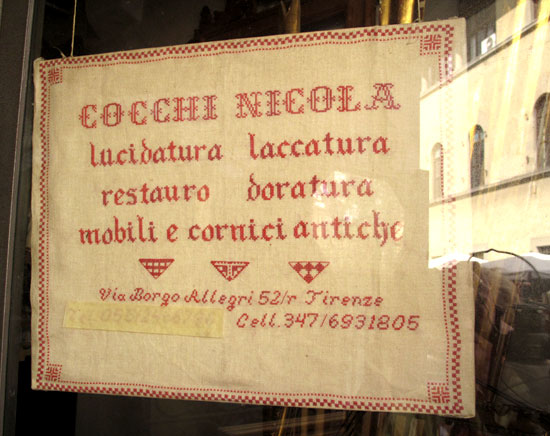
The sellers of this piece were out to lunch. I waited around but they didn’t return, so I simply photographed it. This is a religious symbol for Mary, Mother of God. The “AM” monogram stands for “Ave Maria”. I’ve seen this symbol other places in Italy, such as the cathedral in San Giovanni Valdarno when I was there 2 years ago.
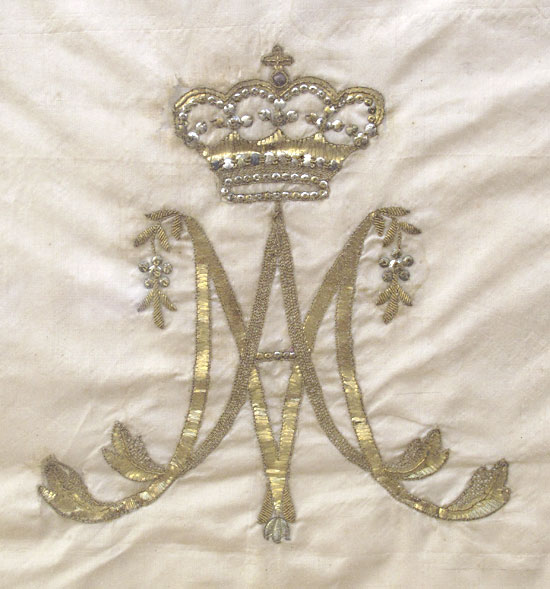
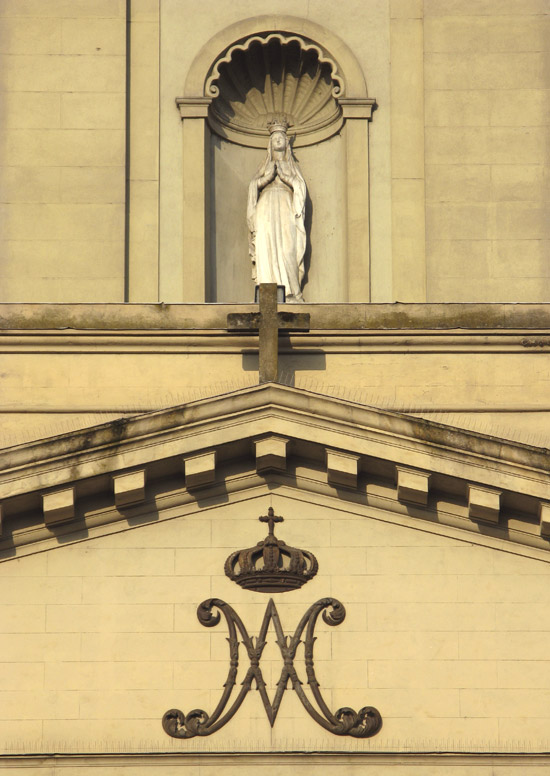
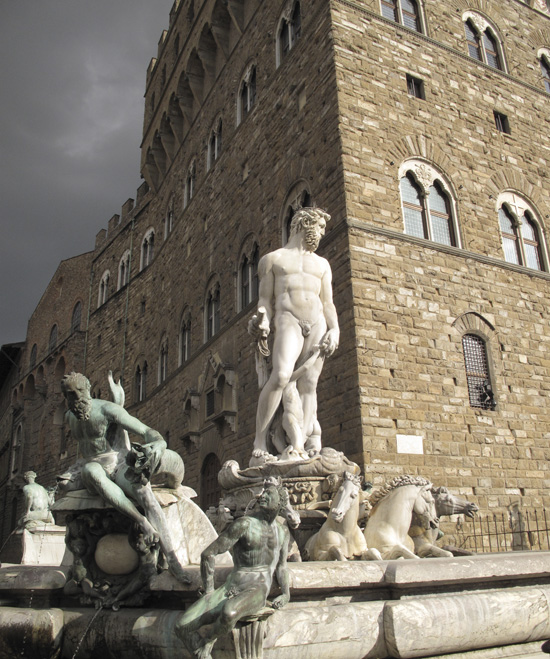
by Maureen | Mar 30, 2010 | Discoveries, Featured Articles, Firenze, Food!, Incredible Locations, Journal, Meals, Photos, Shopping & Markets
If you haven’t been to Firenze (Florence), put it on your “life list” of must-see places in the world. Really.
Two years ago I spent a couple of afternoons exploring Firenze, but I hadn’t been back since I returned to Italy last June. So I hopped on the train late last Friday morning, and less than two hours later, at 1:00, I arrived in Firenze and smiled. I walked from the train station to my hotel shooting photos along the way because I couldn’t wait until I put my bags down. I checked in, changed my clothes for the bit of humidity under the partly sunny skies, then left and took off walking for the next five hours.
If I were to move to Italy NOW, or want to relocate to another spot, I would pick Firenze.
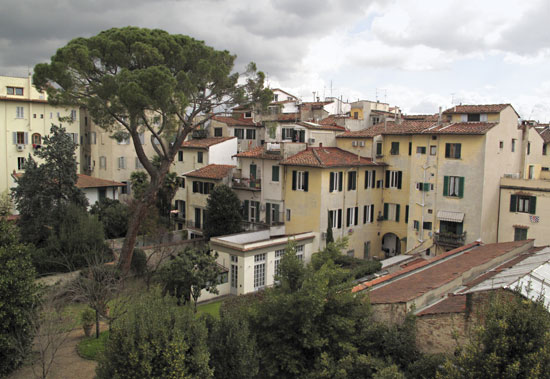
Excerpts from my journal Friday night, 26 March 2010 , while resting my feet and having a delicious dinner:
“I love Firenze! At this point, with what I know and with my familiarity and my language, I’d move to Firenze. Milan was a great place to land and gave me anchors. I find much to interest me there. My camera is always at my side and I can stay as busy as I wish, but in just an afternoon, Firenze has thrilled me with its visuals, much the way that Venezia does.
“It’s very definitely a tourist town! I think that Spring/Easter vacations have begun because the clustering tour groups are everywhere and unavoidable. (I thought that, late March, I’d still be missing them all.)
“Firenze – Florence – is ‘tighter’. Narrower streets close into the center of town around the Duomo, and many ‘pedestrian-only’. the selection of little shops, restaurants and curious places gives much to explore without going far. The antiquity is a saturated wash over the town and gives it a texture that is lush across-the-board. Like Venezia, I could photograph here forever.
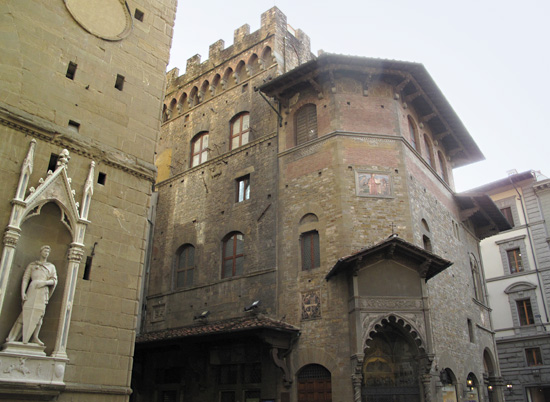
“I’m sitting at a table for two at Zá-Zá, a lovely, dar, funky, delicious trattoria just blocks from my Hotel Caravaggio. There’s been a table of four sitting near me having their meal, their drinks and their desserts. I smiled at them once… As they were leaving, the woman that had been nearest to me said goodbye – ‘Arrivederci‘. That tickles me.” (I highly recommend both the restaurant and the hotel.)
Excerpts from my journal Sunday afternoon, 28 March 2010 , on the train heading home to Milano:
“I had an incredible, full time in Firenze. So glad to have gone back, and with only an hour and 45-minute train ride, I could come for a day if I wanted to, or just an overnight.
“The city of Firenze, though packed with tourists, seems to have a quite comfortable parallel world of locals that go about their days and their work. With transportation and services so readily available, Firenze seems quite livable and pleasant.
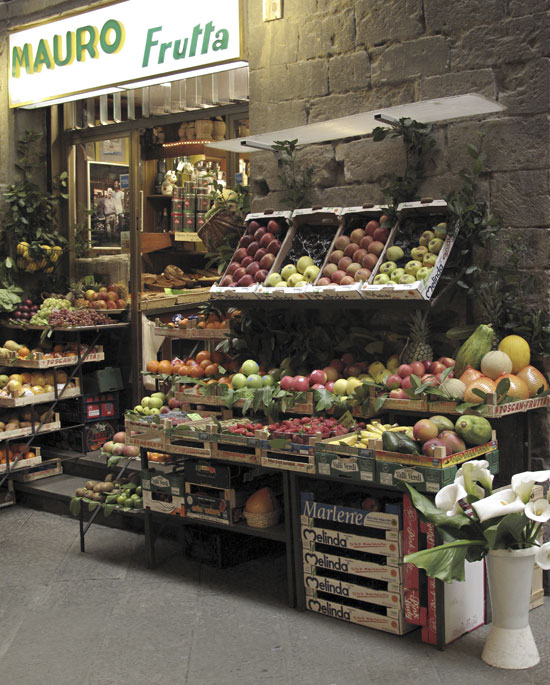
“I very quickly got the-lay-of-the-land and covered much of the “Centro Storico” – the historic center of town – in my two days there, walking close to 20 hours overall.”
Yesterday evening, a friend asked by e-mail, “Should Florence be on my to-do list? What did you especially like about it?” I responded with an off-the-cuff, spontaneous list:
Everyone’s on foot or bike! The whole historic center, large radius, is almost all pedestrian-only with very few cars and some half-size, mini-buses. Walk everywhere. (I don’t think there IS a subway, but lots of public transportation.) Streets are narrow and closer in for easy strolling. NO traffic to even have to think about.
Absolutely fascinating art, history, culture, architecture at EVERY turn!
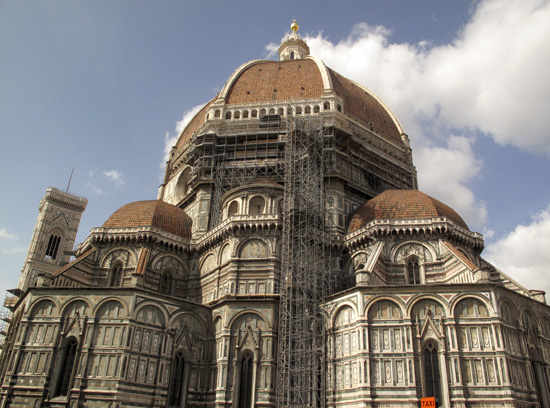

Historic sites. Historic art: Michelangelo’s David. Botticelli. Caravaggio. Dürer. Giotto. Leonardo. Lippi. Raphael. Rembrandt. Rubens. Titian. And so many more!
Visually lush. Vital, Small-city-energy.
VERY tourist-oriented (which I didn’t like having the vacation tours already swarming) but it felt like there was a parallel universe happening of people just going about their lives.
Florence doesn’t have the crazed-busy-frenzy of business-minded Milan.
Cool stuff for curious kids and adults alike. Sundials and crenulated towers.
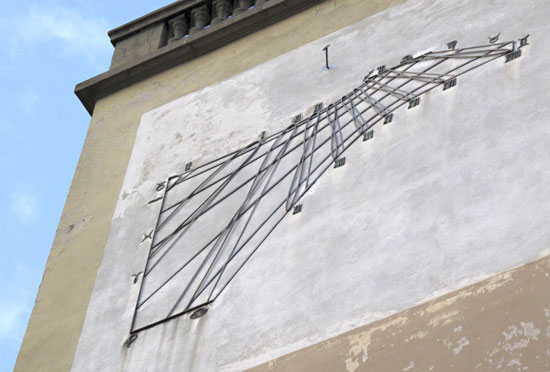
Good gelato.
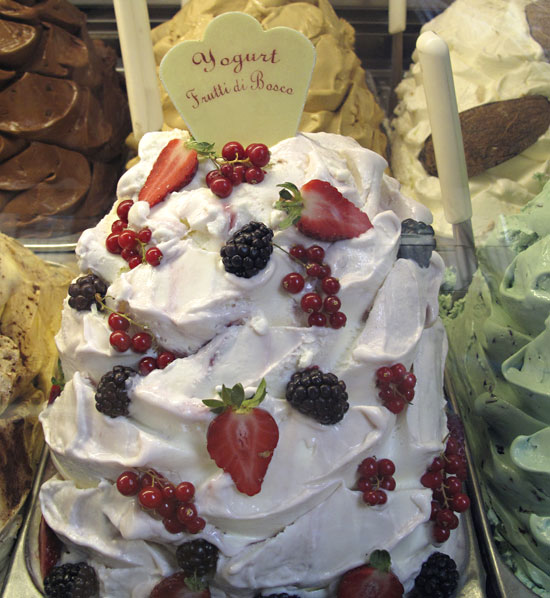
Neat bridges.
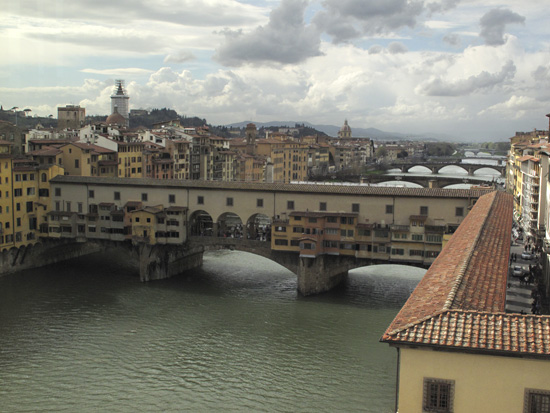
Street markets selling you-name-it.
Good cow-stomach sandwiches. (Lampredotto.)
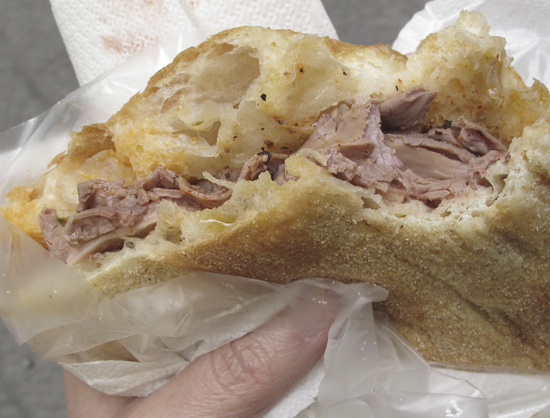
The heartland of the Renaissance.
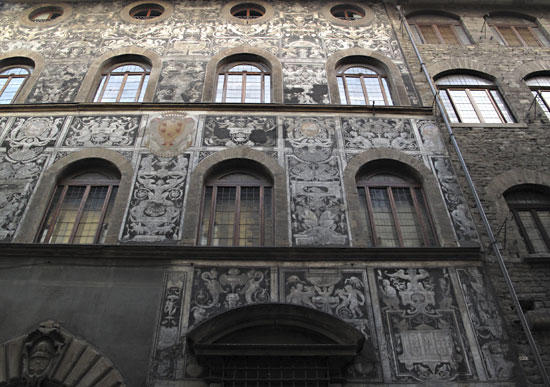
Oh. And they have curb-cuts designed for uninterrupted walking.
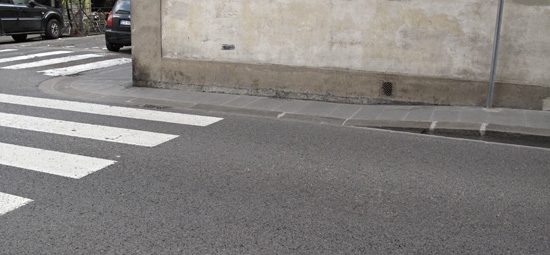
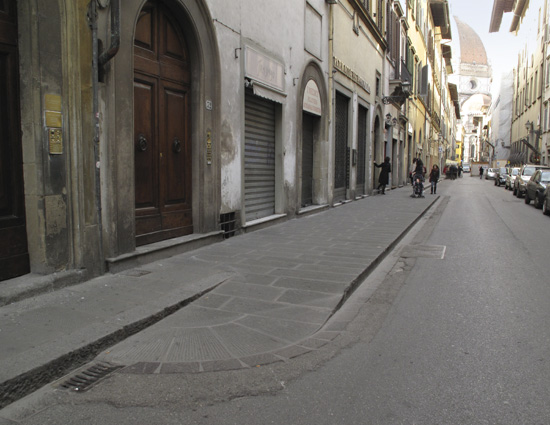
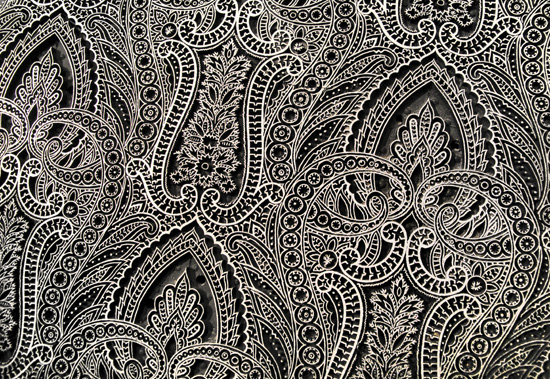
by Maureen | Mar 17, 2010 | Discoveries, Featured Articles, Graphics, Journal, Photo of the Day, Photos
When here in Milano in the summer of 2008, I stumbled upon a Zucchi Store just a half block north of the Duomo. They sell lovely household linens (sheets and towels) and they had a curious display in the window. I didn’t understand what I was seeing, so I had to go in.
Emerging up through a very large, circular hole in the first floor was a towering stack of flat wooden blocks. What were the blocks? It was then that I found out about the Zucchi Collection of wood-and-pewter blocks for printing fabric.
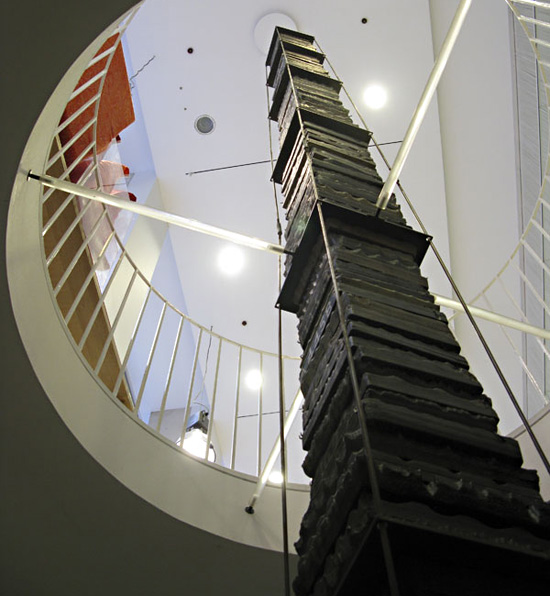
From the Zucchi Website: “The Collection’s 12,000 designs bear witness, over a period which spans three centuries from 1785 to 1935, to a fashion that was both varied and popular. Such tastes were apparent during one of the most energetic and fertile periods of European culture, which ended with the first stylistic experiments of the Art Nouveau and Art Deco movements.
“The Collection houses 56,000 printing blocks, an extraordinary number by any reckoning and one which presents concrete problems not only of space but also of storage in structures able to support the weight of many tonnes. The Collection is housed in three different storage locations: the Zucchi office in Casorezzo, the Via Foscolo location in Milan and a warehouse in Ossona.
“To make the Collection accessible not only to scholars but also to the fashion people, it was necessary to choose criteria by which the artefacts could be subdivided. The Zucchi Collection has been divided into six categories, which are identified in terms of iconographic forms: abstract, cashmere, floral, geometric, ornamental and pictorial. The Collection has been further subdivided according to the specific uses not only for the borders of the materials but also for foulards, bandanas, various ties, scarves and cravats, etc. A special data card, in computerised and paper formats, has been assigned to every series of blocks. Each of these contains various items of information about the handblock concerned, including the number of pieces which make up the structure, the design style it is capable of reproducing, its historical period and its origins. Attention has also been given to the question of conserving these structures and rightly so because the wood is sensitive material. The humidity and temperature levels require strict control and beeswax and turpentine must be applied to maintain the elasticity of the wood.”
A mere fraction of the collection has been on display on the lower floor of the Zucchi Store, including floor-to-ceiling, wall-to-wall shelves holding the numbered wood blocks. (They are now in the process of moving these blocks to another location.) Note that some designs have 3-5 different blocks to create the full design. (They are all numbered alike.) Being a lover of textiles I was immediately enamored of the collection.
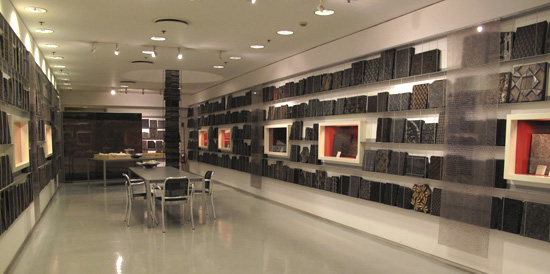
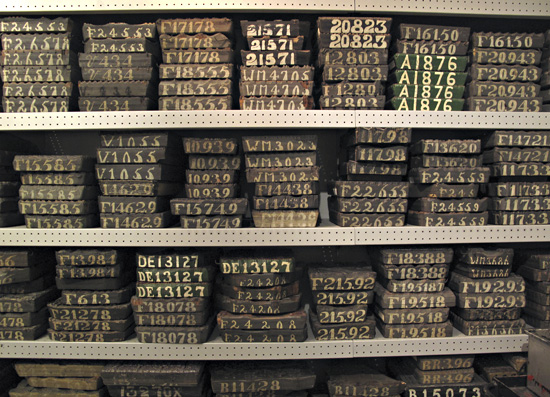
Fast-forward almost 2 years and now I’m living in Milano. Last Fall I found a curious and creative textile studio not far away named “L’Hub” on the Naviglio Grande, the “big” canal. One, they were selling vintage Zucchi linen and cotton dishtowels from the mid- and late-1900s. (Yes. I bought a bunch.) Two, they offer all sorts of creative textile classes including dyeing, sewing, construction, AND printing fabric with the centuries-old Zucchi blocks! Can you say “Sign me up!”?
I enrolled in the 3-hour class held last Saturday afternoon, taught by artist Franco Duranti (at the very far left in the next photo). Among other things, Franco is a painter, engraver, and video artist AND since 2007, he’s been creating original works with the Zucchi wood blocks! Below is a photo of the working studio at L’Hub. Some women were taking a sewing class, while two other women were also taking the fabric stamping class.
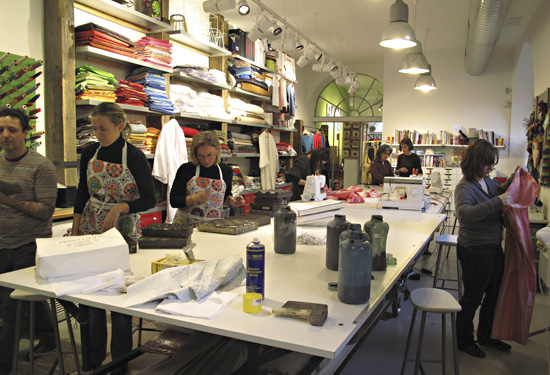
I wanted “classic”. I had just seen the Frette Textile Exhibit a week ago. I’m enthralled by the traditional fabric handwork of generations past and am especially inspired by my Great Great Grandmother’s work, done at age 12 in 1861. She crafted a cross-stitch sampler in “Turkey Red” on cream-colored cloth, and that color combination has launched me ever since my Grandmother gave me the sampler in 1975.
On the neighboring streets (on that recent day when I was getting snowflakes in my eyes) I scouted fabric stores and came away with Italian, 100% Linen. I bought a meter of fabric and took it home to prewash.
In familiarizing myself with the printing process, I chose a simple fleur-de-lis pattern printed in “carminio” – carmine red – on the linen. Note how, in this case, the block carries an “island” of cast pewter attached to the wood,
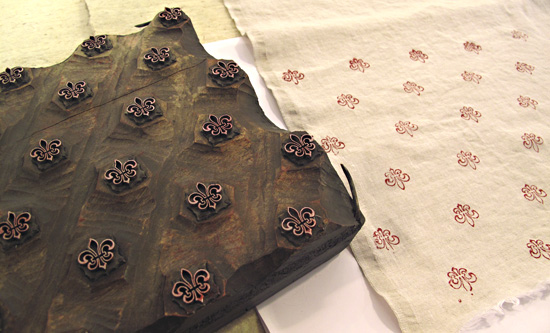
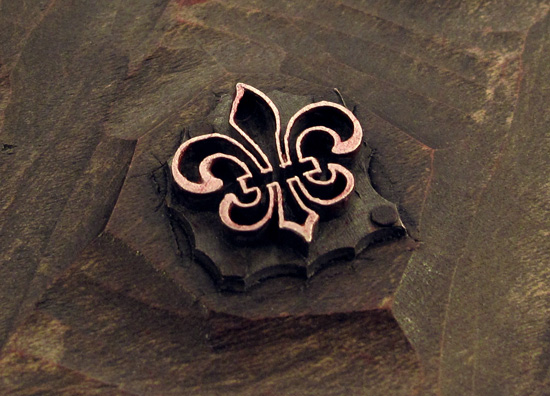
The following is an intricate, cast-pewter, paisley design from the “Cashmere” group of blocks in the collection. THIS makes my heart melt! Unfortunately, I was not able to print with this block, but printed with one I found that was as close as possible.

In gathering fabric for printing, I had also gone BACK to the Zucchi store downtown and they just happened to be having a sale! I bought two sets of sheets. One set is 100% cotton, satin finish with a subtle, printed khaki/cream pattern. I printed right over the top of the pattern to create a set of sheets like no other in the world.
I also paid a visit to the second-hand store 2 blocks away. I found white, cotton button-end pillowcases and bought all six at 2 euro each (about $2.75) When I got them home to wash them, I looked inside and noticed a… Zucchi label! Of course.
My plan now is to return to the L’Hub studio for a solo 3-hour stint to embellish the pieces I began, and to print even more.
As I wallow in Art and Design during my time here in Italy, I can’t imagine a more exhilarating addition to my list of design experiences than printing with the Zucchi handblocks at L’Hub!
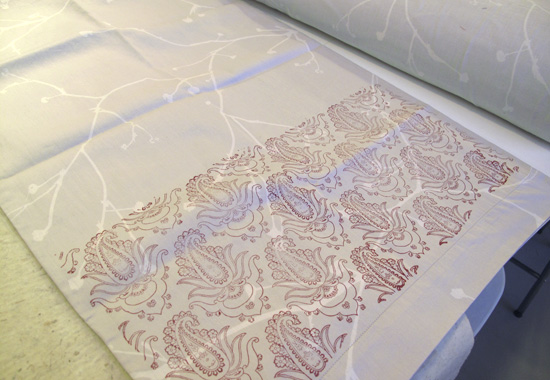
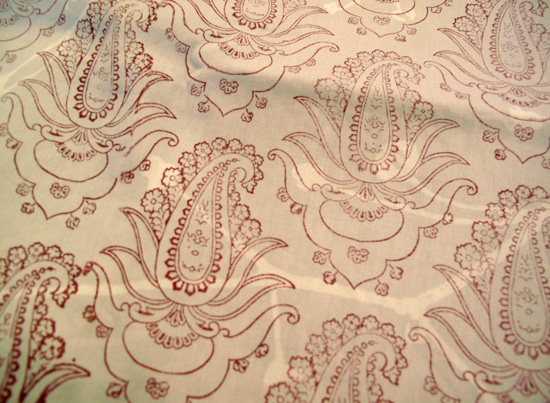
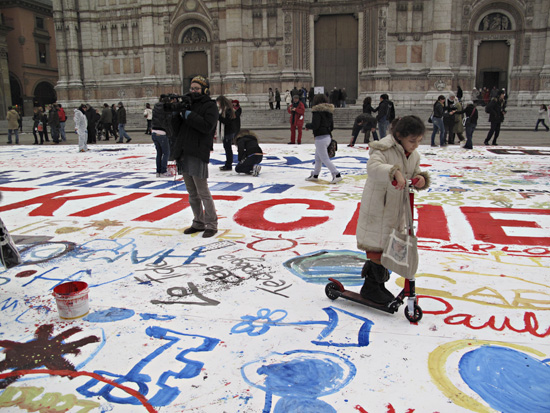
by Maureen | Feb 1, 2010 | Bologna, Discoveries, Featured Articles, Graffiti & Street Art, Incredible Locations, Journal, People, Photos
Scatter sculpture, paintings and installations in amongst mediaeval buildings and you’ve got the makings of a visually exciting weekend! The Bologna Arte Fiera got me into town, but I went about seeing it in a very random manner. I simply stumbled upon the art pieces as I found them.
The piece that was most delightful to me was the very spontaneous, casual creation of a “ground mural” out in front of Bologna’s duomo, San Petronio Basilica. The piece was conceived of by Art Kitchen. They had FILLED the huge Piazza Maggiore with a sheet of paper (pieces unrolled and then attached at the edges), then provided buckets of paint and brushes for anyone that wished to contribute. Families strolled on top of the painting. A little girl pushed by on her scooter. And one man used a push broom to make wide, sweeping black strokes. The piece was interactive and engaging. (These days, those two adjectives are usually applied to electronics and video games.)
Across the middle of the paper, they had painted “Art Kitchen: Make the Sky Bloom.”
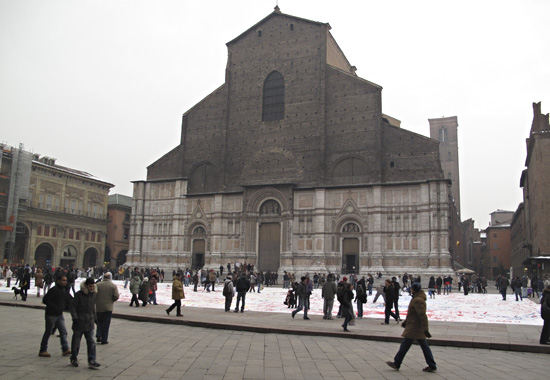
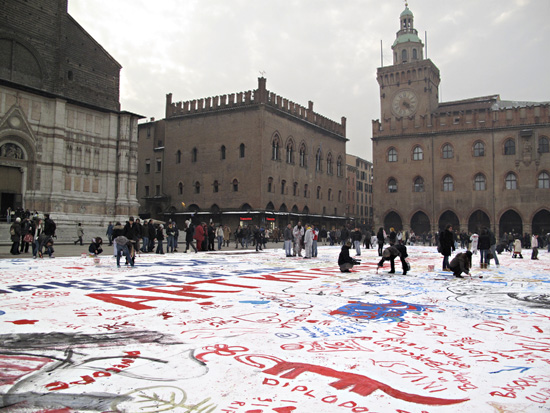

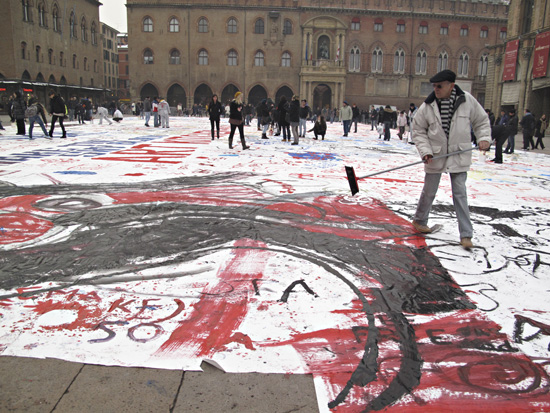
When I had just arrived in town and not far from the train station, I found a group clad in white, disposable coveralls creating this piece. Take note of the chunks of snow/ice they’re using to weigh the paper down.
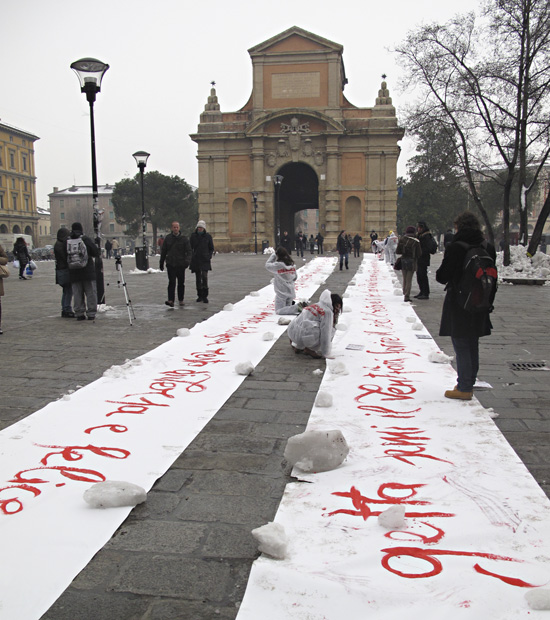
The other art included large, sculptural pieces, flat work and installations. Some I liked; some I didn’t like at all, (but that’s art for ya).
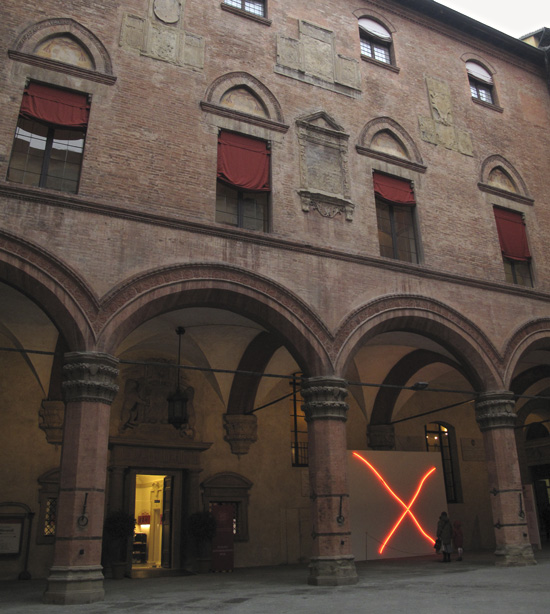
(I want this stone furniture in my yard! It wasn’t a part of the art fair, but shared the courtyard with the sculptural figure behind it.)
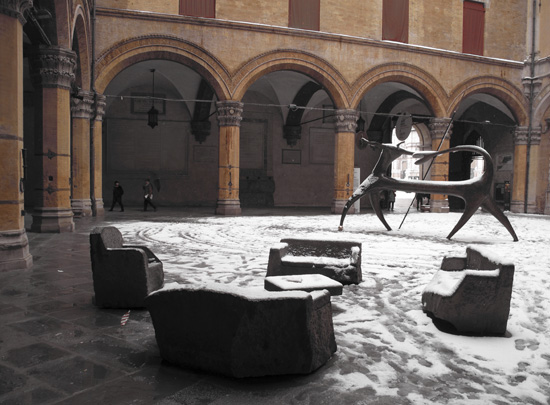
And this installation amused me most after my moment of recognition: they’re drafting templates for engineering drawings! Relics now, I have a drawer full of them in my basement in Seattle but haven’t used them for over 20 years.
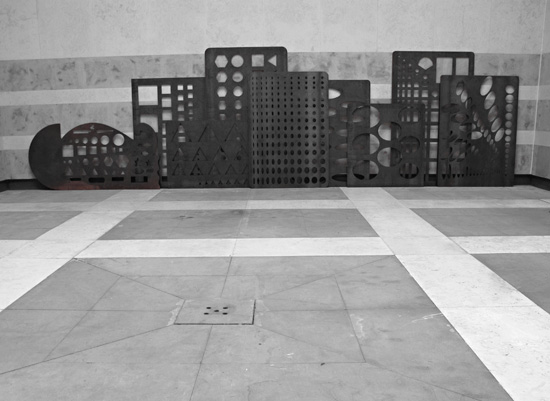
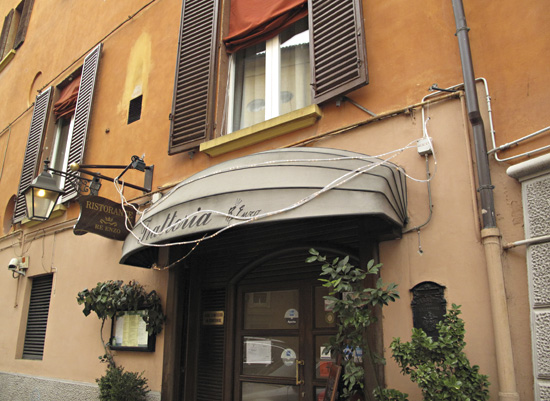
by Maureen | Feb 1, 2010 | Bologna, Discoveries, Food!, Incredible Locations, Journal, Meals, Photos
OK. So add Bologna to my list of amazing places to visit in Italy. It’s right up there with Venice, (which makes me swoon). I have a feeling the list will get VERY long.
A girlfriend from my Italian class had mentioned the citywide art fair, Bologna Arte Fiera, that was going on for a month starting 29 January. “Why don’t you come?”, she suggested. I quickly put plans in place and then hopped on the train Saturday morning.
(Side note: I had bought a ticket for the Frecciarossa fast train, which takes 1 hour instead of 3 and costs 41 euro instead of 11. I read the reader board, saw a train listed for Bologna – but with a 5 minute later departure than my scheduled train – and then hopped on the train and got settled into my seat. An hour into the ride, we weren’t even halfway there and were stopping at every little train station along the way. Uh-oh. I goofed. I had hopped on the slow train instead! Clearly I haven’t learned all the little details yet! Oh well. So I arrived later and saw each little town from the trackside. If there’s one thing I’m learning by being here, it’s to take things in stride, and let them roll off me.)
When I arrived in Bologna I walked a short distance to my hotel, I Portici, dropped my few things in the room then left and took off walking, having no idea where I was going or what there was to see! (Since making this trip was a spontaneous decision, I had only glanced at the site for the art fair, but not Bologna itself.)
I followed my “rule” of exploring the back streets, and found a little restaurant, Re Enzo Ristorante. As I was perusing the menu, the owner/waiter hustled past me with a cloud of truffle scent following him. That made my decision easy! “Scialatelli con Porcini e Tartuffo Bianco” – a wide, flat pasta noodle with porcini mushrooms and white truffles. I added some grilled vegetables to my table, and a nice Sangiovese to sip and the lunch was delicious.

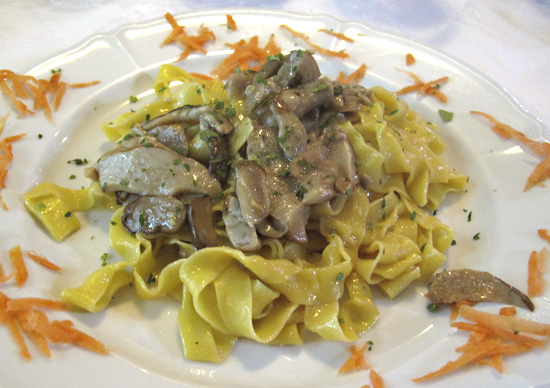
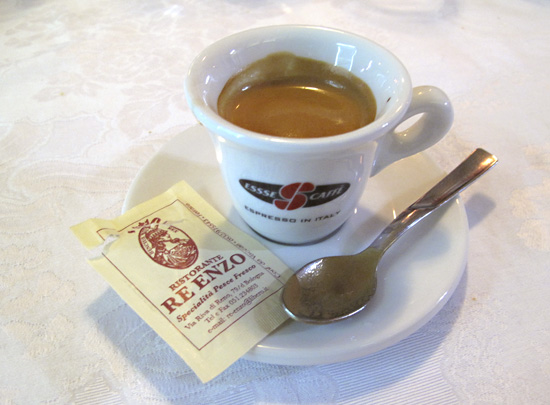
Well-fortified and hunger sated, I started walking around town taking turns whenever I wished and found my way to the historic center of Bologna, Piazza Maggiore. It was a chilly, cold day, but I was bundled up and ready for walking.

by Maureen | Jan 26, 2010 | Bergamo, Discoveries, Featured Articles, Incredible Locations, Journal, Photos
After rising up from the valley floor in the funiculare tram, a short walk brings you to the old plaza, la Piazza Vecchia. Encircled by palaces, a bell tower and a colonnaded portico, the space is punctuated at its center by a Baroque fountain from the late 1700s. The piazza is the heart of the city.Those palaces now house restaurants, hotels, a school and a museum.
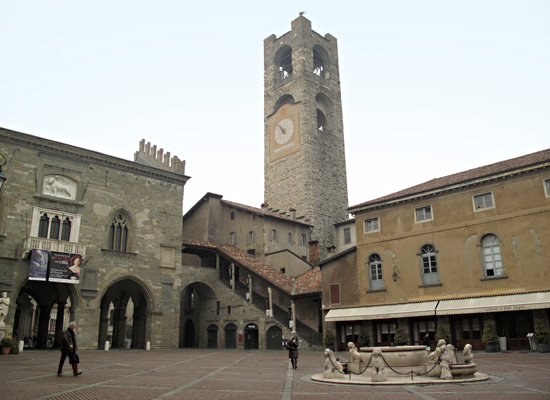
Passing through the portico (at the left in the photo above, under the banners) you find a white marble sundial that was set into the ground in 1798. It points the way north. (It seems to have been restored in 1982.)
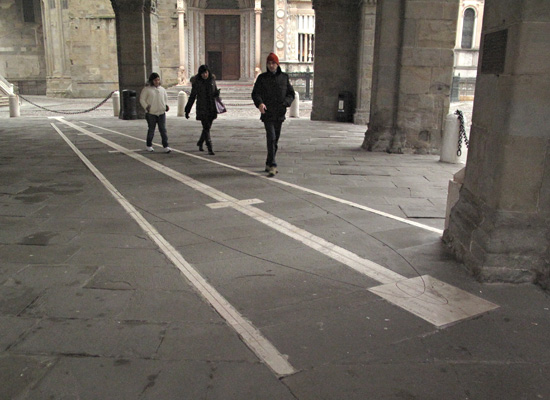
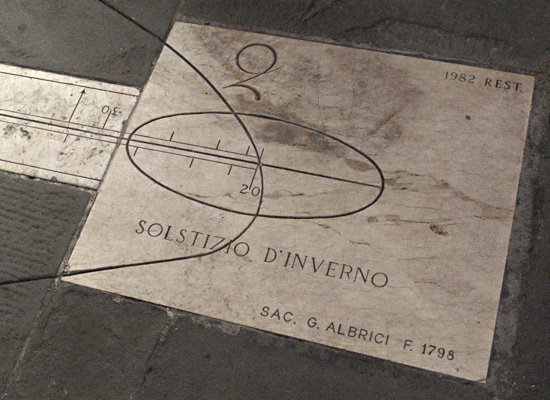
Just beyond the other side of the portico, you step into the Piazza del Duomo, the Plaza of the Cathedral. In mediaeval times this little square was at the political, commercial and religious heart of town. Facing south into the piazza, from your left to right is the Cattedrale di Bergamo (il Duomo), the Basilica di Santa Maria Maggiore, the Cappella Colleoni and the Battistero (Bapistry).
Cattedrale di Bergamo – il Duomo
The ceiling of the Duomo featured gilt patterning and accents to its carved decorations surrounding painted scenes.
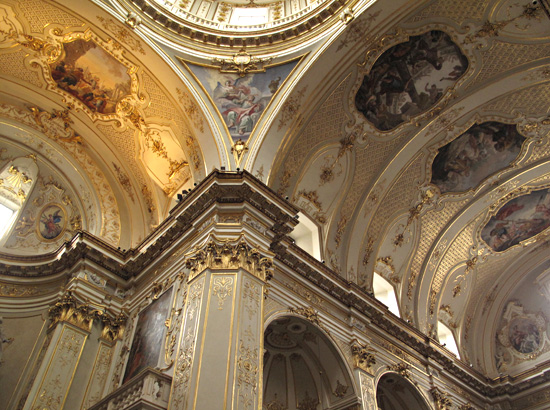
I have a real soft spot for the shrines to Mary. This Madonna della Pietá is in an elaborately carved and embellished side altar.
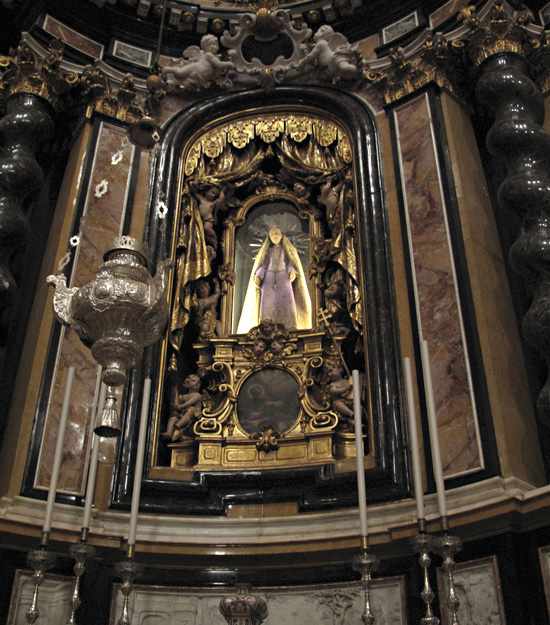
While in the cathedral, I heard chanting and thought perhaps they were playing a recording “for ambience”. No. I followed the singing which lead me down a staircase near the altar. I came to a very modern underground chapel and 50 Nuns at mass, surrounded by a dozen sarcophaghi.
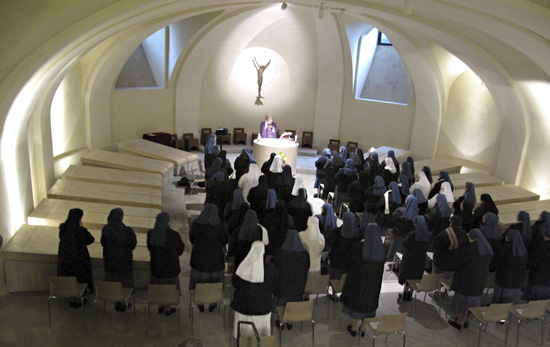
The dominant presence in the Piazza del Duomo is the union of entrances for the Basilica di Santa Maria Maggiore (at left in the photo below) and the Cappella Colleoni (at right).
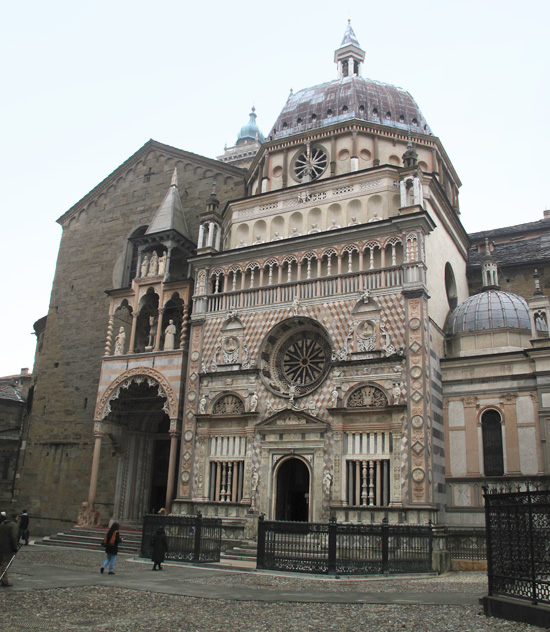
Basilica di Santa Maria Maggiore
The Basilica entry is fairly modest and overshadowed by the Chapel entry at its side. It opens, however, into a great, embellished space.
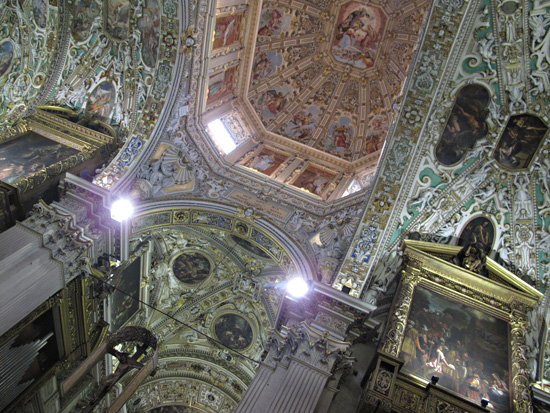
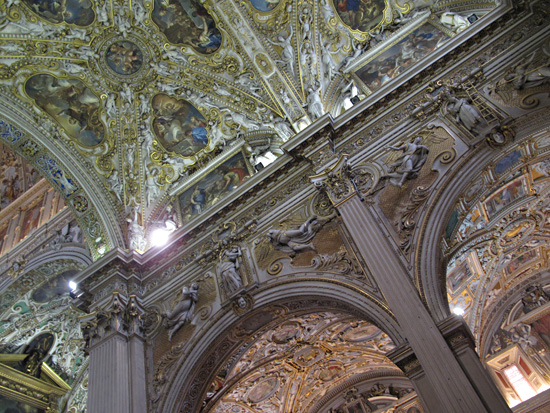
Here’s a shot of the crucifix that hangs over the central altar. (Note the skull and crossbones at the base of the cross.)
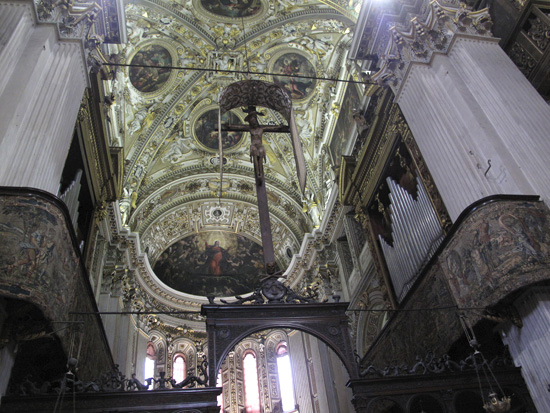
All vertical walls are covered with pictorial tapestries. (Although it was still very cold in there!)
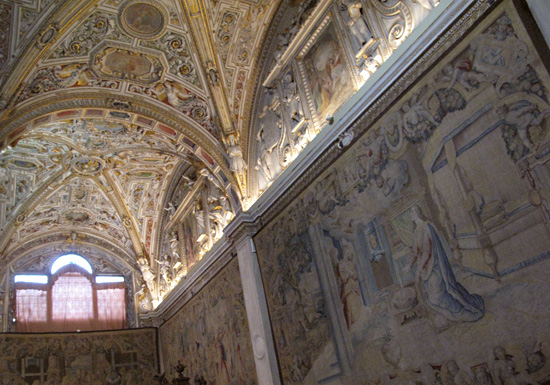
Here is historic Bergamo’s answer to today’s compact PDA/Calendar. This is how they note the times of the masses for week days and weekends.
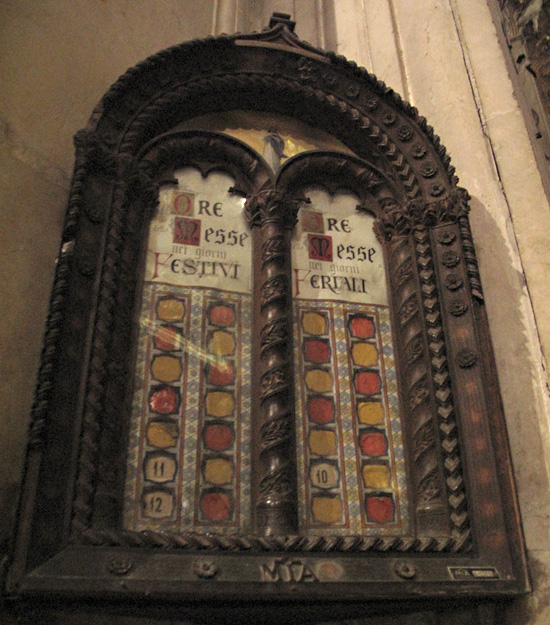
On the outside wall of the Basilica, just to the left of the front door, are permanently-mounted, flat bars of iron that are measuring devices from the Middle Ages. (I can’t find any information about their purpose or unit-of-measure.)
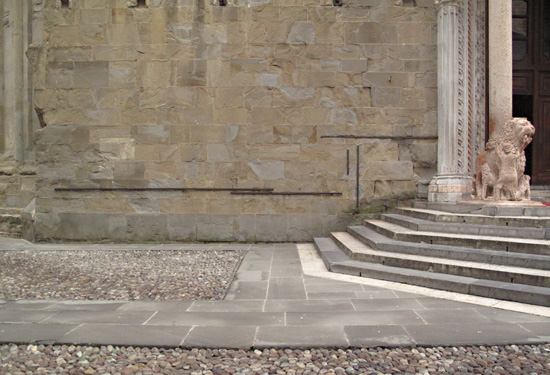
“The Weaver’s Wall” and “the Weaver’s Comb.” (?)


Cappella Colleoni
From a Wikipedia entry: “Dedicated to the saints Bartholomew, Mark and John the Baptist, it was built in 1472-1476 as the personal shrine for the famous condottiere Bartolomeo Colleoni, a member of one of the most outstanding families of the city, and his beloved daughter Medea. The site chosen was that of the sacristy of the nearby church of Santa Maria Maggiore, which was demolished by Colleoni’s soldiers.”
With its 3-D lozenge pattern, the repetition of columns, the figurative sculptures, rose windows, domes and bas-relief panels, no one and no building could compete for stature against this chapel. I think that one could study it all day, as well as the decorated fence surrounding the chapel entry. (No photos were allowed inside.)
The Baptistry
My favorite part of the Baptistry is the decorative ironwork fence around its octagonal shape/
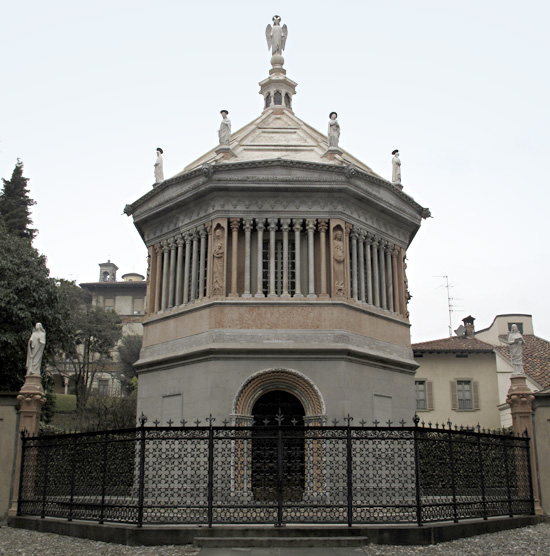
– – –
Note: So very many images and scholarly descriptions are available online that it would feel redundant if I tried to duplicate what’s already been said. I would rather toss out my own personal impressions and show what catches MY eye and mind, and provide enough information so that a blog reader could do their own further research.
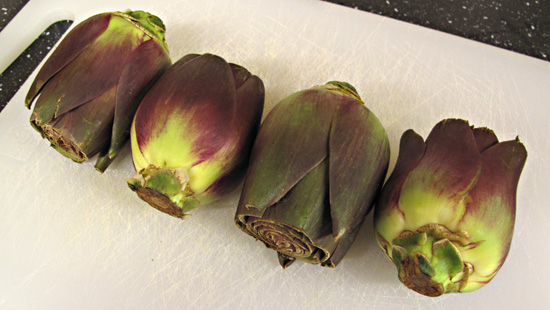
by Maureen | Jan 9, 2010 | Cheese, Christmas & New Year's Eve, Discoveries, Featured Articles, Food!, Journal, Meals, Photos, Shopping & Markets
Have you ever wondered about the first ones to eat something new that they hadn’t encountered before? IS it edible? What PART is edible? Should it be eaten RAW or COOKED? What part do you DISCARD? What part is most DELICIOUS? How is it best PREPARED? What should it be eaten WITH?
Traveling to and cooking in a foreign country is much like being a “primitive man” asking all those questions about newly encountered food items. But at least when you walk into a grocery store or step up to a market stall, someone has done the preselection for you and you’re not out in the woods trying to discern edibility. If it’s in the store, SOME part of it must be edible.
For the last couple of months I’ve been seeing these very small, young, almost-flower-like artichoke heads in the street markets and grocery stores. Very beautiful, but what do they DO with them?! I had no idea, and passed them up, regretfully. I had eaten marinated artichokes scooped out of little jars. Had steamed softball-sized heads and eaten them, leaf-by-leaf dipping the ends in butter. And I’ve eaten that sinfully fat-laden, hot dip with artichoke hearts, cheese, mayo and who knows what else. But I’d never done much else with them or seen them offered other ways. Yes, I’m sure the recipes and methods are out there, but the ones I just mentioned seem to be the across-the-board standards for eating artichokes.
On the evening of New Year’s Day, I was out walking around the Duomo and decided to have dinner out. I picked one of the few restaurants that were open, perused the menu and decided I HAD to have “Insalata di Carciofi Crudi” – Salad of Raw Artichokes! I ordered a “Pizza di Quatro Formaggi” – a four cheese pizza – to go with the salad, but that was secondary in my mind.
What arrived at my table was a bowl with paper thin shavings of very young, tender artichokes, including about an inch of the stem. They had been drizzled with a “fruttato” – “fruity” – extra virgin olive oil and lemon juice, sprinkled with salt and freshly ground pepper and tossed together with some thinly sliced grana cheese. Wow! Delicious! Simple, fresh in the middle of winter and quite a surprise. NOW I knew what could be done with those flowery artichokes.
Tonight, at the grocery store, I didn’t pass them up. They sold some untrimmed with thorny tips and 8 inches of stem, and they sold trimmed, packaged groups of 4. I considered the prices and how much would be thrown away from either and bought those that had been trimmed.
Usually, I would “just wing it” and approximate what I had tasted on New Year’s Day, but I decided to look online to see if there were any guidelines to follow. In doing so I found a handy Italian cooking website: Buonissimo.org. (Sorry. It’s all in Italian.) The recipe I found was what I had surmised and described above.

I removed the outer, half dozen tougher leaves and trimmed both ends to freshen them up. Then I cut the flower heads in half.
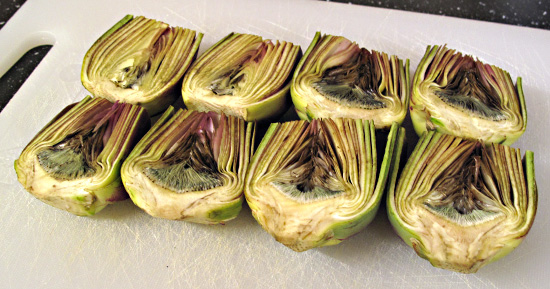
Since I don’t have a mandolin slicer here, I used my best Shun Tomato Knife, sharp and serrated, and sliced the artichokes as thinly as I could. (I left the furry inner parts, figuring they hadn’t gotten prickly.) I put it all in a bowl with the grana padano cheese (a nutty, almost sweet, hard cheese similar to parmesan), abundant lemon juice and extra virgin olive oil. Shook a little sea salt and grated some fresh pepper then gave it a gentle tossing.
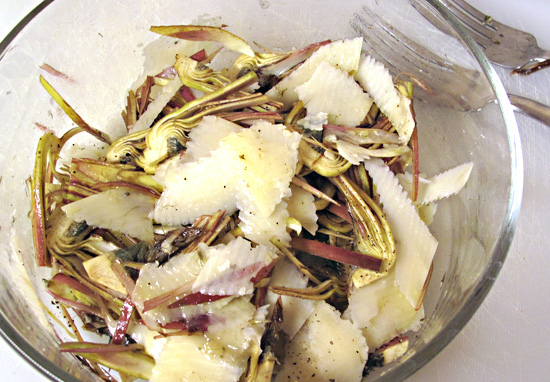
With my heaped serving of “Insalata di Carciofi Crudi”, I ate Norwegian, farm-raised salmon seasoned with Seattle’s Tom Douglas’ sweet/peppery Salmon Rub. The salad will become one of my new favorites. (If nothing else, it’s certainly good for the roughage!) But are the artichokian flowers available in the States?!
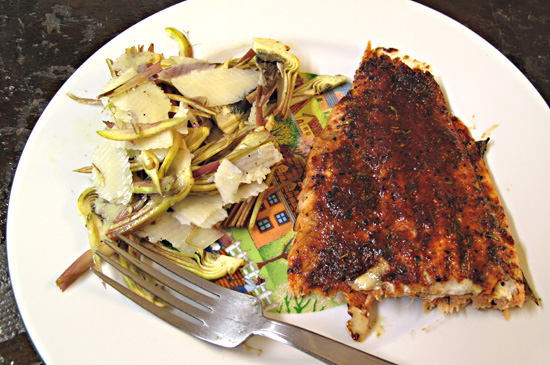

by Maureen | Jan 7, 2010 | Discoveries, Featured Articles, Journal, People, Photos
Gotta love these Italians. They had two national, Catholic holidays at the beginning of December. Then two weeks off for Christmas and New Years. Then, today is the Feast of the Epiphany, also a national holiday. (Italy is about 98% Catholic.) A lot of people took this whole week off since they were already on a two week break and why come back for two days, have one day off, and then come back for two more days before the weekend? Might as well extend the two weeks into three.
There was a parade through town for the Epiphany. Actually two parades: the official one of Magi and Wise Men, then the parade of older, Milanese women in their fur coats. I must have seen a thousand fur coats today. Boggling.
After rain, snow, cold and gray, the 45 degree day brought the crowds out. It seemed that this must be the traditional time to strut one’s fur. Amazing. I was more amused by playing sleuth photographer and people-watching than I was by the pageant of the “real” parade.
(I shudder at some of the faces of these women. Some look cold and hard.)
The furs were worn with argyle, cashmere and hand-knit. With fur hats and berets. There were full-length, knee-length, sporty-short, wraps and stoles. There were SO many women in furs, that it was comical, an exaggeration. Was anyone else noticing?
